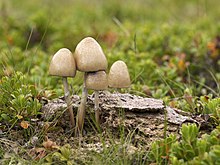
Panaeolus cinctulus, syn. Panaeolus subbalteatus, commonly known as the banded mottlegill, weed Panaeolus, belted panaeolus, or subbs is a very common, widely distributed psilocybin mushroom. According to American naturalist and mycologist David Arora, Panaeolus cinctulus is the most common psilocybin mushroom in California.

Panaeolus is a genus of small, black-spored, saprotrophic agarics. The word Panaeolus is Greek for "all variegated", alluding to the spotted gills of the mushrooms produced.

Agaricus campestris is a widely eaten gilled mushroom closely related to the cultivated A. bisporus. A. campestris is commonly known as the field mushroom or, in North America, meadow mushroom.
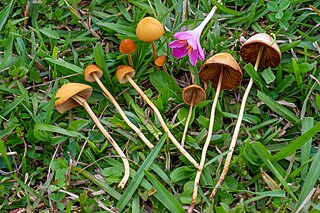
Conocybe tenera, commonly known as the brown dunce cap or common cone head, is a widely distributed member of the genus Conocybe. This mushroom is the type species for the genus Conocybe.

Panaeolus cyanescens is a mushroom in the Bolbitiaceae family. Panaeolus cyanescens is a common psychoactive mushroom and is similar to Panaeolus tropicalis.
Panaeolus africanus is a little brown mushroom that contains irregular amounts of the hallucinogens psilocybin and psilocin. It has been found in central Africa and southern Sudan.
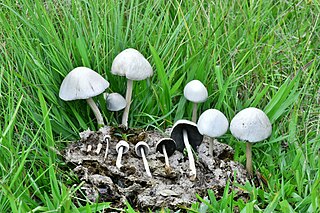
Panaeolus antillarum is a species of mushroom in the family Bolbitiaceae. It is edible but not commonly eaten. It is found from northern North America through Mexico into northern South America.

Panaeolus bisporus, also known as Copelandia bisporus is a rare and widely distributed little brown mushroom that bruises blue and contains the hallucinogen psilocybin.
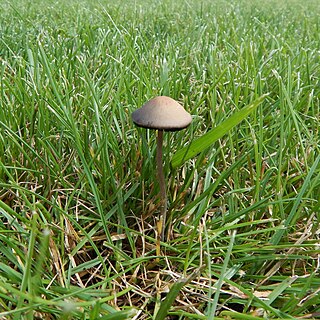
Panaeolus fimicola is a widespread but seldom identified "little brown mushroom" which sometimes contains small amounts of the hallucinogen psilocybin. Panaeolus ater is a synonym. The species is also referred to as the "turf mottlegill".

Panaeolus papilionaceus, also known as Agaricus calosus, Panaeolus campanulatus, Panaeolus retirugis, and Panaeolus sphinctrinus, and commonly known as Petticoat mottlegill, is a very common and widely distributed little brown mushroom that feeds on dung.

Panaeolus semiovatus var. phalaenarum is a common and widely distributed medium-sized grey mushroom that grows on dung.

Russula fragilis, commonly known as the fragile russula, or fragile brittlegill, is a species of mushroom of the genus Russula, whose members are commonly known as brittlegills. It is a small, fragile, long stemmed, and variably coloured brittlegill, found in mixed forests, and woods in Europe, Asia, and North America.

Aspropaxillus giganteus, also Leucopaxillus giganteus, commonly known as the giant leucopax or the giant funnel, is a saprobic species of fungus in the order Agaricales. As its common names imply, the fruit body, or mushroom, can become quite large—the cap reaches diameters of up to 50 cm (20 in). It has a white or pale cream cap, and is funnel-shaped when mature, with the gills running down the length of the stem. Considered by some to be a choice edible when young, this species has a cosmopolitan distribution, and is typically found growing in groups or rings in grassy pastures, roadside hedges, or woodland clearings. It has been shown to contain a bioactive compound with antibiotic properties.

Leucopaxillus albissimus, commonly known as the large white leucopaxillus, is a species of mushroom that lives as a saprobe, decaying the litter under coniferous trees. It produces a large white fruiting body that is unusually resistant to decay. It is considered to be inedible.
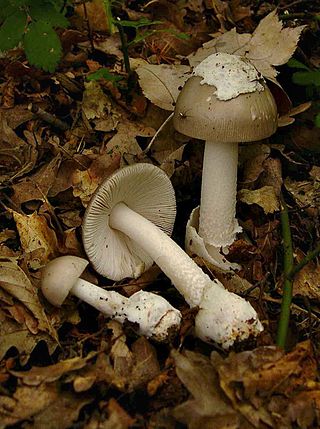
Amanita vaginata, commonly known as the grisette or the grisette amanita, is an edible mushroom in the fungus family Amanitaceae. The cap is gray or brownish, 5 to 10 centimetres in diameter, and has furrows around the edge that duplicate the gill pattern underneath. Unlike many other Amanita mushrooms, A. vaginata lacks a ring on the stem.

Agrocybe pediades, commonly known as the common fieldcap or common agrocybe, is a typically lawn and other types of grassland mushroom, but can also grow on mulch containing horse manure. It was first described as Agaricus pediades by Swedish mycologist Elias Magnus Fries in 1821, and moved to its current genus Agrocybe by Victor Fayod in 1889. A synonym for this mushroom is Agrocybe semiorbicularis, though some guides list these separately. Technically it is edible, but it could be confused with poisonous species, including one of the genus Hebeloma.

Lactarius subflammeus, commonly known as the orange milk cap, is a species of fungus in the family Russulaceae. It is found in western North America in the late summer and fall and is especially common in the Pacific Northwest, where it grows on the ground near conifers like pine and spruce. The brightly colored fruit bodies, which are slimy or sticky, have scarlet caps when young that soon fade to brilliant orange. The stem—typically longer than the width of the cap—is also bright orange but the gills are whitish. The mushroom secretes a whitish latex when it is cut or injured.

Lactarius argillaceifolius is a species of fungus in the family Russulaceae. The mushrooms produced by the fungus have convex to flattened drab lilac-colored caps that are up to 18 cm (7.1 in) wide. The cream-colored gills are closely spaced together and extend slightly down the length of the stem, which is up to 9 cm (3.5 in) long by 3.5 cm (1.4 in) thick. The mushroom produces an off-white latex when injured that stains the mushroom tissue brownish.

Protostropharia semiglobata, commonly known as the dung roundhead, the halfglobe mushroom, or the hemispherical stropharia, is an agaric fungus of the family Strophariaceae. A common and widespread species with a cosmopolitan distribution, the fungus produces mushrooms on the dung of various wild and domesticated herbivores. The mushrooms have hemispherical straw yellow to buff-tan caps measuring 1–4 cm (0.4–1.6 in), greyish gills that become dark brown in age, and a slender, smooth stem 3–12 cm (1.2–4.7 in) long with a fragile ring.
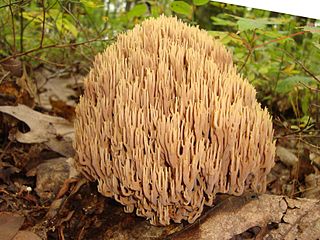
Ramaria stricta, commonly known as the strict-branch coral or strict coral mushroom, is a coral fungus of the genus Ramaria. It has a cosmopolitan distribution, and grows on dead wood, stumps, trunks, and branches of both deciduous and coniferous trees. Its fruit body is up to 10 cm tall, made of multiple slender, compact, and vertical parallel branches. Its color is typically light tan to vinaceous-brown. All parts of the mushroom will bruise when handled. There are several lookalike corals that can usually be distinguished from R. stricta by differences in coloration, bruising reaction, or microscopic features. The fungus is inedible due to its unpleasant odor and bitter taste.
